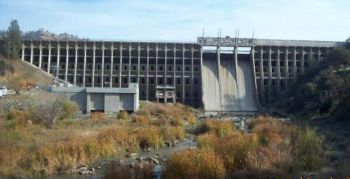Design and Construction of Buttress Dams: Difference between revisions
No edit summary |
No edit summary |
||
| Line 1: | Line 1: | ||
[[Category:Buttress Dams]] | [[Category:Buttress Dams]] | ||
---- | ---- | ||
{{Picture | |||
|image= | |||
<!-- Add image file name (ex.image.jpg) --> | |||
1.jpg | |||
|link= | |||
<!--https://www.usbr.gov/ssle/damsafety/risk/BestPractices/Presentations/E5-ButtressDamsPP.pdf--> | |||
|caption= | |||
<!-- Add picture caption --> | |||
An example of a typical slab and buttress dam. ([https://www.usbr.gov/ssle/damsafety/risk/BestPractices/Presentations/E5-ButtressDamsPP.pdf USBR, 2019]) | |||
}} | |||
Buttress dams were constructed mainly in early 20th century when labor was cheap and materials were expensive. Buttress dams reduced the concrete required to build a typical gravity dam by as much as 60 percent. For [[stability]], these relatively light structures required upstream sloping water barriers resulting in the water force acting downward. These structures were designed to carry load in stream direction, but typically did not consider [[seismic]] or other loadings in the cross-stream direction and are therefore vulnerable to these conditions.<ref name="Buttress">[https://www.usbr.gov/ssle/damsafety/risk/BestPractices/Presentations/E5-ButtressDamsPP.pdf Buttress Dams (United States Bureau of Reclamation, 2019)]</ref> | |||
Finite element analyses of an entire buttress structure is needed to understand the [[structural]] response. Cracking or yielding of reinforced concrete members does not necessarily equal dam failure for buttress-type structures.<ref name="Buttress"/> | |||
<!-- For information on notation for in text citations visit https://www.mediawiki.org/wiki/Help:Cite Or simply enclose the citation as shown <ref> citation </ref> in the location of the in text mention. Citations will automatically populate below--> | <!-- For information on notation for in text citations visit https://www.mediawiki.org/wiki/Help:Cite Or simply enclose the citation as shown <ref> citation </ref> in the location of the in text mention. Citations will automatically populate below--> | ||
Revision as of 22:27, 28 November 2022

|
| An example of a typical slab and buttress dam. (USBR, 2019) |
Buttress dams were constructed mainly in early 20th century when labor was cheap and materials were expensive. Buttress dams reduced the concrete required to build a typical gravity dam by as much as 60 percent. For stability, these relatively light structures required upstream sloping water barriers resulting in the water force acting downward. These structures were designed to carry load in stream direction, but typically did not consider seismic or other loadings in the cross-stream direction and are therefore vulnerable to these conditions.[1]
Finite element analyses of an entire buttress structure is needed to understand the structural response. Cracking or yielding of reinforced concrete members does not necessarily equal dam failure for buttress-type structures.[1]
Citations:
Revision ID: 4614
Revision Date: 11/28/2022
